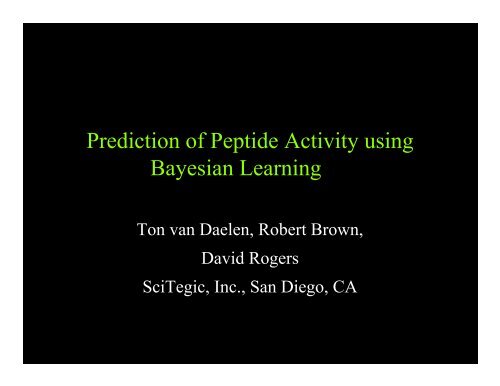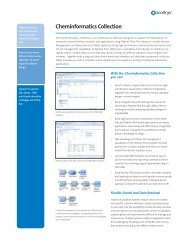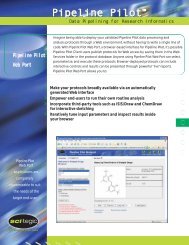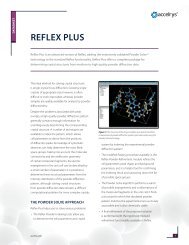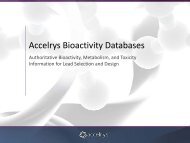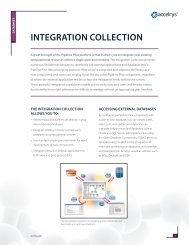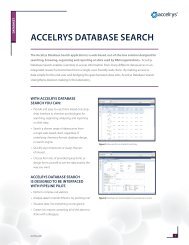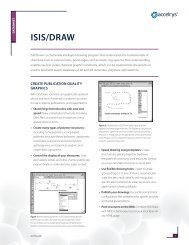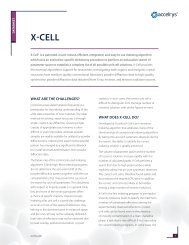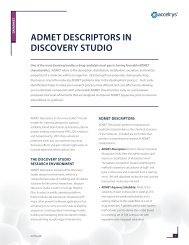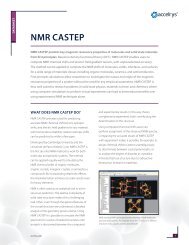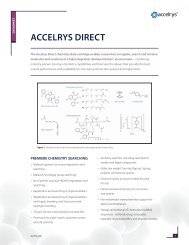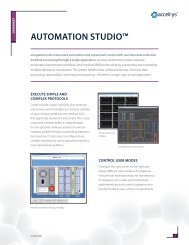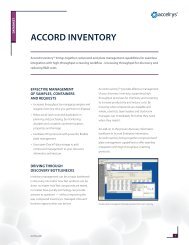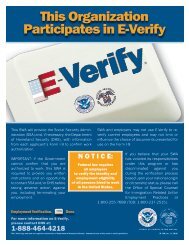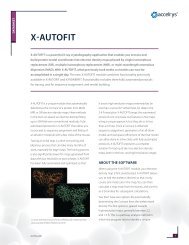Prediction of Peptide Activity using Bayesian Learning - Accelrys
Prediction of Peptide Activity using Bayesian Learning - Accelrys
Prediction of Peptide Activity using Bayesian Learning - Accelrys
Create successful ePaper yourself
Turn your PDF publications into a flip-book with our unique Google optimized e-Paper software.
<strong>Prediction</strong> <strong>of</strong> <strong>Peptide</strong> <strong>Activity</strong> <strong>using</strong><br />
<strong>Bayesian</strong> <strong>Learning</strong><br />
Ton van Daelen, Robert Brown,<br />
David Rogers<br />
SciTegic, Inc., San Diego, CA
• Goals <strong>of</strong> this project<br />
• <strong>Bayesian</strong> learning<br />
– Descriptors for peptides<br />
Outline<br />
• MHC peptide data set<br />
– Validation <strong>of</strong> the model<br />
– Scoring virtual peptide libraries<br />
• Conclusions<br />
…ask more more <strong>of</strong> your data<br />
data
Goals<br />
• Relate peptide immunogenic potency to peptide<br />
sequence, <strong>using</strong> a frequency based approach<br />
– Investigate applicability <strong>of</strong> <strong>Bayesian</strong> statistics<br />
– Generate suitable descriptor set<br />
…ask more more <strong>of</strong> your data<br />
data<br />
• “Propose” novel peptides with high probability <strong>of</strong><br />
exhibiting immunogenic potency
<strong>Bayesian</strong> Classification<br />
…ask more more <strong>of</strong> your data<br />
data<br />
• Build a model which estimates the likelihood that a<br />
given data sample is from a "good" subset <strong>of</strong> a larger<br />
set <strong>of</strong> samples<br />
• Characteristics<br />
– Relative predictor<br />
– Good with high-dimensional data<br />
– Scales linearly; efficient for large data sets<br />
– Works for a few as well as many ‘good’ examples<br />
– Can model broad classes <strong>of</strong> compounds (i.e. multiple modes<br />
<strong>of</strong> action)
<strong>Bayesian</strong> Modeling Applied to<br />
Chemical Structure<br />
…ask more more <strong>of</strong> your data<br />
data<br />
• Choose appropriate descriptors<br />
– Continuous (e.g. molweight, LogP, #donors, #Acceptors)<br />
– Structural fingerprints<br />
• This doesn’t work well for peptides<br />
– Molecular fingerprints describe presence and absence <strong>of</strong><br />
substructural features, not their arrangement with respect to<br />
one another<br />
AAAAWWWW AWAWAWAW<br />
≠
…ask more more <strong>of</strong> your data<br />
data<br />
Generating Molecular Fingerprints<br />
• Structure is fragmented<br />
according to a particular set<br />
<strong>of</strong> rules<br />
• Each fragment generates a<br />
code that represents an ‘on’<br />
bit in the final bit string<br />
• Fingerprint bits indicate<br />
presence and absence <strong>of</strong><br />
certain structural features<br />
C C<br />
0001100100101110001<br />
C O<br />
C<br />
N<br />
O<br />
Initial Molecule<br />
N<br />
C C<br />
O<br />
..0001100100011100000101…<br />
N<br />
-878476476<br />
-456475878<br />
127126636<br />
3487326457<br />
2835789992<br />
Etc.<br />
C<br />
O<br />
N<br />
O
<strong>Bayesian</strong> Statistics Applied to<br />
Non-Chemistry Data<br />
• Sequence based descriptors<br />
…ask more more <strong>of</strong> your data<br />
data<br />
• Procedure<br />
– For a given sequence, select all consecutive amino-acid codes<br />
<strong>of</strong> size 1 .. N<br />
– N is typically between 3 and 6<br />
– Keep only unique examples<br />
• Example<br />
– Simple AA sequence<br />
• VDAELEN<br />
– Text descriptor (fingerprint) <strong>of</strong> maximum length 4 has 21 ‘bits’<br />
• V;VD;VDA;VDAE;D;DA;DAE;DAEL;A;AE;AEL;AELE;E;EL;<br />
ELE;ELEN;L;LE;LEN;EN;N
Derived Fingerprints<br />
…ask more more <strong>of</strong> your data<br />
data<br />
• Goal<br />
– Reduced size <strong>of</strong> fingerprint space supporting smaller data sets<br />
– For interpreting fundamental properties <strong>of</strong> the sequence<br />
• Hydrophobicity<br />
– Translate each AA into Polar and A-Polar<br />
– Example (max length 4):<br />
• Raw sequence: VDAELEN<br />
• Pol. sequence: APAPAPP<br />
• Pol. fingerprint: A;AP;APA;APAP;P;PA;PAP;PAPA;PAPP;APP;PP<br />
• Chemical class<br />
– Translate each AA into Aliphatic, Cyclic, Aromatic (E), Hydroxyl or Sulphur<br />
groups, basic, acidic/amides (O)<br />
– Example (max length 4):<br />
• Raw sequence: VDAELEN<br />
• Chem. sequence: AOAOAOO<br />
• Chem. fingerprint: A;AO;AOA;AOAO;O;OA;OAO;OAOA;OAOO;AOO;OO
MHC-Binding <strong>Peptide</strong>s<br />
• Major Histocompatibility Complex (MHC)<br />
is a large complex <strong>of</strong> tightly linked genes<br />
that encodes molecules involved in many<br />
aspects <strong>of</strong> the immune response<br />
• MHC is the most polymorphic gene<br />
complex known (coding to Class I and<br />
Class II MHC proteins)<br />
• The proteins expressed by the MHC genes<br />
are the receptors for large virus and bacteria<br />
proteins. The peptides in our study<br />
represent fragments <strong>of</strong> the virus/bacteria<br />
that bind to the receptor<br />
…ask more more <strong>of</strong> your data<br />
data
MHC <strong>Peptide</strong> Data Set<br />
• 13,362 peptides binding to<br />
human and mouse MHC proteins<br />
• Most peptides between 8 and 16<br />
amino acids in length<br />
% <strong>of</strong> samples<br />
30%<br />
25%<br />
20%<br />
15%<br />
10%<br />
5%<br />
0%<br />
Histogram <strong>of</strong> length<br />
0 5 10 15<br />
length<br />
20 25 30<br />
Frequency<br />
…ask more more <strong>of</strong> your data<br />
data<br />
source mhc Frequency # duplicates<br />
human HLA-A2 962 334<br />
human HLA-DR4 924 263<br />
human HLA-DR1 715 57<br />
mouse I-Ad 418<br />
human HLA-B27 348 90<br />
mouse I-Ek 335<br />
human HLA-DR2 324 1<br />
mouse I-Ed 300<br />
human HLA-DR11 295 184<br />
mouse H-2Kd 293 1<br />
human HLA-DR7 283 77<br />
mouse I-Ak 276 1<br />
human HLA-A3 260 16<br />
human HLA-B35 226 9<br />
human HLA-A11 211 24<br />
human HLA-DR5 200<br />
mouse H-2Kb 196 2<br />
human HLA-DR3 189 3<br />
human HLA-B8 185<br />
mouse H-2Kk 183<br />
human HLA-B7 176 8<br />
mouse I-Ag7 171<br />
mouse H-2Db 166<br />
human HLA-D? 165<br />
human HLA-DR17 154 7<br />
human HLA-A24 149 2<br />
human HLA-? 143 6
Immunogenic Potency Data<br />
• Immunogenic potency (activity)<br />
determined by T-cell based<br />
assays<br />
• <strong>Activity</strong> is reported as PD50<br />
(peptide dose 50)<br />
– Dose giving 50% lysis (cell<br />
destruction)<br />
PD50<br />
< 1nm<br />
10 µm-1µm<br />
> 10 µm<br />
<strong>Activity</strong><br />
High<br />
Moderate<br />
Inactive<br />
Unknown<br />
# samples<br />
556<br />
1100<br />
379<br />
11327<br />
…ask more more <strong>of</strong> your data<br />
data<br />
Source Sequence MHC <strong>Activity</strong><br />
human KGILGIVFTLTV HLA-A2 Unknown<br />
human FSHDYRGSTSHRL HLA-DR7 Unknown<br />
human EREEALTTNVWIEMQWCDYR HLA-DR2 Unknown<br />
human EELAKQAEELAKL HLA-DP9 Unknown<br />
human HDYNFVKAINAIQKSW HLA-DR11 Unknown<br />
human MGLLECCARCLVGAPFASLV HLA-DR51 Unknown<br />
human FLHSGTAKSV HLA-A2 Unknown<br />
mouse AEGASYTVANKAKGIT I-As High<br />
human WWAGVGRAR HLA-DR11 Unknown<br />
human LXRGSMXGL HLA-B7 Unknown<br />
human LPCRIKQII HLA-B51 Unknown<br />
human QYIKAQSKFIGITE HLA-DR7 Unknown<br />
human IPLPKQYQPY HLA-B35 Unknown<br />
human EYKLVVVGADGVGKSALT HLA-DR15 Unknown<br />
human CFLAMLSLFICGTAGIFLMA HLA-DR4 Unknown<br />
mouse YAATASTMDHARHGFLPRHRDTI-Ag7 Unknown<br />
human RLVTLKDIV HLA-A2 Unknown<br />
human VHFFKNIVAPRTP HLA-DR15 Unknown<br />
human XLDSDXERL HLA-A2 Unknown<br />
human LIGFRKEIGRMLNI HLA-DR1 Unknown<br />
human ASCIGLIY HLA-B35 High<br />
mouse FEDTGNLI H-2Kk Unknown<br />
human RRYQKSTVL HLA-B27 Inactive<br />
mouse FESNFATQATNR I-Ak Unknown<br />
mouse QADHAAHAEIN I-Ad Unknown<br />
human APRSNGMVX HLA-B7 Unknown<br />
mouse DLIAYLKQQTK I-Ek Inactive<br />
human SRYWAIRTRSGGI HLA-DR7 Unknown<br />
human MLDSVPLLLG HLA-A2 Unknown
Raw Data Example<br />
>HUM1014A#<br />
MHC MOLECULE: HLA-A2, CLASS-1, (HUMAN)#<br />
METHOD: cytotoxicity as.#<br />
ACTIVITY: yes, little#<br />
BINDING: yes, ?#<br />
SOURCE: Influenza matrix protein (53-68)#<br />
DB REFERENCE: SWISS: (VMT1_IACKB,VMT1_IAANN,VMT1_IAFOW,VMT1_IAWIL,VMT1_IAMAN,#<br />
& VMT1_IABAN,VMT1_IALE1,VMT1_IAUSS,VMT1_IAUDO,VMT1_IAPUE,#<br />
& VMT1_IALE2,VMT1_IAZI1)#<br />
& PIR1: (JN0392,MFIV61,MFIV,MFIV1M,MFIVC,MFIV1K,MFIVWS)#<br />
& PIR2: (S04052,S04056,S14616,S04054,S04050,S07429,S04058)#<br />
REFERENCES: bodmer89a#<br />
COMMENT:#<br />
SUMMARY: HLA-A2,actyesl,bindyesu,SPLTKGILGFVFTLTV*#<br />
SEQUENCE: SPLTKGILGFVFTLTV*<br />
• Data to extract<br />
– Source (human, mouse, …)<br />
– <strong>Peptide</strong> sequences, source, activity data<br />
…ask more more <strong>of</strong> your data<br />
data
Parse Raw Data<br />
Extract <strong>Activity</strong>,<br />
sequence, activity<br />
Classify activity<br />
Remove duplicate<br />
sequences<br />
Generate Text FPs<br />
Translate to<br />
Pol/Chem FPs<br />
Work Flow<br />
Random split in<br />
training/test<br />
Build model Validate model<br />
Generate Virtual<br />
<strong>Peptide</strong>s<br />
Score <strong>using</strong> Model<br />
Sort<br />
Report<br />
…ask more more <strong>of</strong> your data<br />
data<br />
Parse Known<br />
<strong>Peptide</strong>s<br />
Data pipelining – Pipeline Pilot
…ask more more <strong>of</strong> your data<br />
data<br />
Validating the MHCPEP Model<br />
• Receiver operating<br />
characteristics (ROC) curve<br />
– Method for validating<br />
classification models<br />
– Shows sensitivity versus<br />
specificity<br />
• Area under the curve is a<br />
measure <strong>of</strong> test accuracy<br />
(1=perfect, 0.5=random)<br />
• MHC activity model<br />
– Sequence fingerprint<br />
– Length = 5<br />
– ROC = 0.85<br />
True Positive Rate<br />
ROC Curve (Accuracy 0.85: Good)<br />
100%<br />
90%<br />
80%<br />
70%<br />
60%<br />
50%<br />
40%<br />
30%<br />
20%<br />
10%<br />
0%<br />
0% 20% 40% 60% 80% 100%<br />
False Positive Rate
…ask more more <strong>of</strong> your data<br />
data<br />
ROC as a Function <strong>of</strong> Fingerprint Length<br />
• ROC analyses were<br />
performed for different<br />
fingerprint types and<br />
fingerprint lengths<br />
• Sequence fingerprint is<br />
most powerful descriptor<br />
• Sequence fingerprint has<br />
converged at length 5<br />
• Polarization and chemical<br />
fingerprints converge<br />
more slowly and result in<br />
poorer model<br />
ROC<br />
1.00<br />
0.95<br />
0.90<br />
0.85<br />
0.80<br />
0.75<br />
0.70<br />
0.65<br />
0.60<br />
0.55<br />
0.50<br />
1 2 3 4 5 6 7 8 9<br />
FP Length<br />
Seq<br />
Pol<br />
Chem
• Best features<br />
– AA sequence<br />
The MHCPEP <strong>Bayesian</strong> Model<br />
–Polar/a-polar<br />
– Chemical class<br />
…ask more more <strong>of</strong> your data<br />
data<br />
Bin ID G1 G2 G3 G4 G5 G6 G7 G8 G9 G10 G11 G12 G13 G14 G15 G16<br />
Bin Value PGNYP PGNY APGN APGNY NYP PGN FAP GNYP APG FAPG GNY YPAL NYPA NYPAL FAPGN YPA<br />
Feature Count 22 22 22 22 34 25 29 26 45 21 31 34 22 22 12 38<br />
Subset Count 22 22 22 22 28 22 24 22 30 18 22 23 17 17 12 23<br />
Bin ID G1 G2 G3 G4 G5 G6 G7 G8 G9 G10<br />
Bin Value AAAAP AAAPA AAPAP AAAAA AAAP PPAPP AAAA AAA PAPPA APAPP<br />
Feature Count 1038 1212 1204 738 2107 1043 1313 2450 1035 1073<br />
Subset Count 73 82 79 48 132 65 81 148 59 60<br />
Bin ID G1 G2 G3 G4 G5 G6 G7 G8 G9 G10<br />
Bin Value AEAES BOASB EAESA CAOEC AAEAE ACAOE EAES AEABO OECAA ABOAS<br />
Feature Count 47 57 46 19 61 23 61 72 27 76<br />
Subset Count 24 27 23 13 25 13 24 26 13 27
The MHCPEP <strong>Bayesian</strong> Model<br />
• ‘Worst’ features<br />
– AA sequence<br />
–Polar/a-polar<br />
– Chemical class<br />
…ask more more <strong>of</strong> your data<br />
data<br />
Bin ID B1 B2 B3 B4 B5 B6 B7 B8 B9 B10 B11 B12 B13 B14 B15 B16 B17 B18 B19 B20<br />
Bin Value WV SG VR IS TD FI RS KF YN YD AEI LN NK YE QAV QQ WV GG DQ RW<br />
Feature Count 164 161 154 146 144 115 107 99 92 88 83 174 168 73 71 70 67 151 66 65<br />
Subset Count 0 0 0 0 0 0 0 0 0 0 0 1 1 0 0 0 0 1 0 0<br />
Bin ID B1 B2 B3 B4 B5 B6 B7 B8 B9 B10<br />
Bin Value PPPPP PAPAP PPPAA AAPAA APAAP APAA PAAPP PPAAP PAPAA APAAA<br />
Feature Count 397 699 1012 1116 1051 2041 1003 1076 992 982<br />
Subset Count 7 13 26 29 29 65 33 37 35 35<br />
Bin ID B1 B2 B3 B4 B5 B6 B7 B8 B9 B10<br />
Bin Value SSO ASOAA AOAS AAAAO OEAAA BBB ABAB EAAAO OSSA SBB<br />
Feature Count 195 118 106 101 99 96 93 92 92 90<br />
Subset Count 0 0 0 0 0 0 0 0 0 0<br />
Normalized Probability -2.31 -1.87 -1.78 -1.74 -1.72 -1.70 -1.67 -1.66 -1.66 -1.64
…ask more more <strong>of</strong> your data<br />
data<br />
Proposing <strong>Peptide</strong>s with High <strong>Activity</strong><br />
• Can we generate novel peptides with high likelihood <strong>of</strong> being active?<br />
• A combinatorial peptide library built from 20 amino acids:<br />
– <strong>Peptide</strong> <strong>of</strong> length 10: 20^10 = 1.0E13<br />
– The haystack is too big!<br />
• Need a more focused search<br />
– Select all peptide fragments <strong>of</strong> size 2 among best 200 features<br />
– Combine with 20 amino acids<br />
– Randomly pick a ‘bit’ to build peptides <strong>of</strong> size 8, 9, 10<br />
Building blocks<br />
A F G I L M P V W C D E H K N Q R S T Y<br />
KQ VF GF CD AP PA TK FA LK NY FV YP YL FT<br />
<strong>Peptide</strong>s generated<br />
VF;AP;G;NY;PA;L VFAPGNYPAL<br />
– I;L;G;FV;FT;LK;L .<br />
ILGFVFTLKL
Scoring the Virtual Library<br />
• Generated 100M ‘virtual’<br />
peptides (5h30 min)<br />
• Scored and sorted virtual and<br />
known peptides <strong>using</strong> <strong>Bayesian</strong><br />
model<br />
• High scoring virtual compounds<br />
suggest novel peptide<br />
chemistries to explore or<br />
motives to search for in protein<br />
data bank<br />
…ask more more <strong>of</strong> your data<br />
data<br />
Source MHC Sequence Bits MHCPEP <strong>Activity</strong><br />
human HLA-B51 ILGFVFTLTV 36.19 Unknown<br />
human HLA-A2 ILGFVFTLTV 36.19 Unknown<br />
human HLA-A69 ILGFVFTLTV 36.19 Moderate<br />
VFAPGNYPAL VF;AP;G;NY;PA;L 35.76<br />
human HLA-A2 GILGFVFTLT 35.26 Moderate<br />
ILGFVFTLKL I;L;G;FV;FT;LK;L 34.36<br />
mouse H-2Db FAPGNYPAL 34.02 Unknown<br />
mouse H-2Kb FAPGNYPAL 34.02 High<br />
mouse H-2Kd FAPGNYPAL 34.02 Unknown<br />
LKQAPGNYPA L;KQ;AP;G;NY;PA 33.88<br />
YLKQAPGNYP YL;KQ;AP;G;N;YP 33.52<br />
PALGFVFTLK PA;L;GF;VF;T;LK 32.95<br />
YLGFVFTLKL YL;GF;V;FT;LK;L 32.71<br />
human HLA-A2 ILGFVFTLT 32.57 Moderate<br />
FAPGFVFTLK FA;P;GF;V;FT;LK 32.52<br />
AYLKQAPGNY A;YL;KQ;AP;G;NY 32.49<br />
human HLA-B51 LGFVFTLTV 32.34 Unknown<br />
FAPGNYPATL F;AP;G;NY;PA;T;L 32.32<br />
VKQAPGNYPA V;KQ;AP;G;NY;PA 32.18<br />
PGNYPAYLKQ P;G;NY;PA;YL;KQ 32.14<br />
YLGFVFTLKQ YL;GF;V;FT;L;KQ 32.09<br />
MGFAPGNYPA M;GF;AP;G;NY;PA 32.08<br />
TVFAPGNYPA T;VF;AP;G;NY;PA 31.85<br />
VFAYLKQATK V;FA;YL;KQ;A;TK 31.69<br />
TKQAPGNYPA TK;Q;AP;G;NY;PA 31.67<br />
mouse I-Es IAYLKQATK 31.58 Unknown<br />
mouse I-Ek IAYLKQATK 31.58 Unknown<br />
mouse I-Eb IAYLKQATK 31.58 Unknown<br />
QVFAPGNYPA Q;VF;AP;G;NY;P;A 31.55<br />
VFAPGNYPA VF;AP;G;NY;PA 31.54<br />
LGFVFTLTK L;GF;V;FT;L;TK 31.46
Scoring the Virtual Library<br />
• Generated 100M ‘virtual’<br />
peptides (5h30 min)<br />
• Scored and sorted virtual and<br />
known peptides <strong>using</strong> <strong>Bayesian</strong><br />
model<br />
• High scoring virtual compounds<br />
suggest novel peptide<br />
chemistries to explore or<br />
motives to search for in protein<br />
data bank<br />
…ask more more <strong>of</strong> your data<br />
data<br />
Source MHC Sequence Bits MHCPEP <strong>Activity</strong><br />
PAPGNYPALK PA;P;G;NY;PA;LK 31.32<br />
FAPGNYPAFT F;AP;G;N;Y;PA;FT 31.31<br />
human HLA-A2 GILGFVFTL 31.26 Moderate<br />
mouse H-2Db GILGFVFTL 31.26 Unknown<br />
human HLA-A69 GILGFVFTL 31.26 Unknown<br />
GFVFTLKQAP GF;VF;T;LK;Q;AP 31.25<br />
VFAPGNYPAG VF;AP;G;NY;PA;G 31.1<br />
human HLA-A2 AILGFVFTL 31.05 High<br />
VFAPGNYPAN VF;AP;G;N;YP;A;N 31.02<br />
APGNYPALTK AP;G;N;Y;PA;L;TK 31.01<br />
LFAYLKQATK L;FA;YL;KQ;A;TK 30.94<br />
GNYPAFVFTL G;NY;PA;FV;FT;L 30.6<br />
FAYLKQATKQ FA;YL;KQ;A;T;KQ 30.6<br />
FAPYLGFVFT FA;P;YL;GF;V;FT 30.59<br />
GFAPGFVFTL GF;AP;GF;V;FT;L 30.56<br />
LGFVFTLKL L;G;F;VF;T;LK;L 30.51<br />
PALGFVFTL PA;L;GF;V;FT;L 30.5<br />
IAYLGFVFTK I;A;YL;GF;VF;TK 30.49<br />
QYLGFVFTLK Q;YL;GF;V;FT;LK 30.48<br />
mouse H-2Kb QAPGNYPAL 30.47 High<br />
GNYLGFVFTL G;NY;L;GF;VF;T;L 30.47<br />
APGNYPFVFT AP;G;NY;P;FV;FT 30.46<br />
GAPGNYPALK G;AP;G;NY;PA;LK 30.31<br />
YNYPALGFVF Y;NY;PA;L;GF;VF 30.3<br />
APGFVFTLKQ AP;GF;VF;T;L;K;Q 30.28<br />
APGNYPALFA A;P;G;NY;PA;L;FA 30.26<br />
APGNYPALK AP;G;NY;PA;LK 30.15<br />
human HLA-A2 KILGFVFTL 30.14 High<br />
FAYLKQATKI FA;YL;KQ;A;TK;I 30.11<br />
YLGFVFTLTG YL;GF;V;FT;L;T;G 30.1<br />
GFVFAPGNY GF;VF;AP;G;NY 30.07<br />
mouse H-2Kb RAPGNYPAL 30.06 High
Conclusions<br />
…ask more more <strong>of</strong> your data<br />
data<br />
• This initial exploration showed<br />
– Fast approximate modeling works for peptide data<br />
– Fingerprint based descriptors <strong>of</strong> sequence fragments gives<br />
good results over broad range <strong>of</strong> data<br />
– Chemical based abstractions gave poorer results for MHC<br />
binding (can be more useful for other types or binding)<br />
• Pipeline Pilot is a good prototyping environment
• Carol Gorst (SciTegic)<br />
Acknowledgements<br />
• Andrei Caracoti (SciTegic)<br />
• Visit us at the exhibition at the MDL booth<br />
…ask more more <strong>of</strong> your data<br />
data


